Furniture in Public Collections in Canada / La Collection Nationale de Mobilier
Royal Ontario Museum:
European Department
1 The European Department's furniture collection, which numbers about 1,000 examples depending on what is included as "furniture," is undoubtedly the most important holding of non-Canadian furniture in the Western tradition to be found in Canada. The museum's first director, C.T. Currelly, began the collection with the intention of documenting the development of style, technology, and changing patterns of life. It still serves in this capacity as a teaching and research tool; students from the University of Toronto, Ryerson Polytechnical Institute, and the Ontario College of Art, researchers, and collectors regularly consult the collection. It is also used by the public schools for tours to supplement the study of literature and history. Pieces from the collection have been loaned for special exhibitions such as "The Art and Mind of Victorian England" (The Forbes Magazine Collection of Pictures) in Minneapolis, Minnesota, in 1974, and in a few cases put on extended loan to responsible institutions.
2 The collection extends from a handful of items of the late Gothic period, ca. 1500, to a set of three American plate glass tables ca. 1945. The British section is the best developed with a full range of furniture from the late Tudor period, ca. 1600, to the late Victorian period. Although many of the British examples are of routine quality, there are a number of gems in the collection, especially among the tables. A series of five console tables (see fig. 1) traces the development of this form from its baroque origins in the early eighteenth century when it was an important focal point of interior architecture to the modest and functional console table of the Regency period. A similar, useful series is found among the "convenience furniture" of the period 1780-1810. This furniture, which opened up or unfolded for use, includes an exceptionally fine harlequin table with a central storage section that rises up from the top, two desks, a dressing table, and a music stand. Although the department does not possess a great quantity of Victorian furniture, certain of the Victorian pieces are of outstanding quality, notably a Jennens and Bettridge japanned table, ca. 1840, a Holland and Company chiffonier, ca. 1868, and a gilt pedestal table with an inlaid hardstone top, ca. 1870. The British clocks and barometers number about thirty items dating between 1700 and 1830. These should be mentioned in passing since they are part of interior furnishings and the tall case examples frequently demonstrate fine cabinetmaking techniques such as marquetry and seaweed marquetry.
 Display large image of Figure 1
Display large image of Figure 13 The Continental furniture is not as numerous as the British. The early English oak furniture is paralleled by an important grouping of Italian, French and Spanish walnut furniture of the sixteenth and seventeenth centuries. Presently this is complimented by a loan of about a dozen important pieces of central European furniture of the eighteenth century. French eighteenth-century furniture is represented by about two dozen pieces, some of them signed. The French Régence settee (fig. 2) and two armchairs, ca. 1715-20 and still retaining original St. Cyr needlework upholstery and original gilding, are outstanding. Furniture in this state of repair and of this quality is almost non-existent. This grouping is the subject of an article by Jean Basco, formerly an associate curator in the department: "The Splendour of Régence; Magnificent French Furniture," Rotunda 6, no. 1 (Winter 1973): 4-13. A drop-front desk, ca. 1775-80, by A.F. Delorme, a gift from the Larkin family, is the most important piece among the later French furniture. There is a serious shortage of Empire furniture in the collection and almost no Continental material to parallel the English Victorian era.
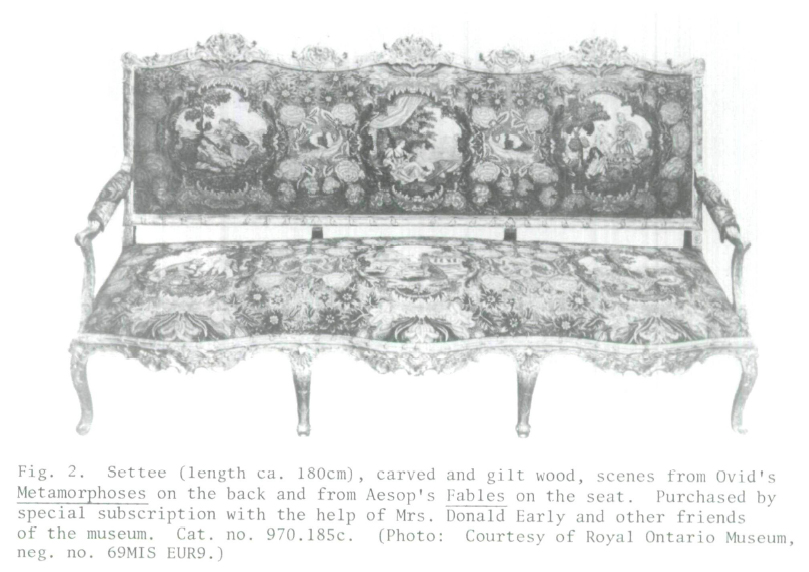 Display large image of Figure 2
Display large image of Figure 24 Art Nouveau is represented by a walnut buffet (fig. 3) in the sinous naturalistic style, a Vienna Secession buffet and serving buffet by Alajos Polgar of Budapest, ca. 1910, and a chair (fig. 4) and tall case clock reminiscent of Mackintosh designs. Art Deco is represented by a pedestal table by Jules Émile Leleu, Paris, ca. 1920, an American tub chair, ca. 1930, and the New York tables mentioned earlier. It is very possible that more furniture in post-1900 styles will be added to the collection in the coming years.
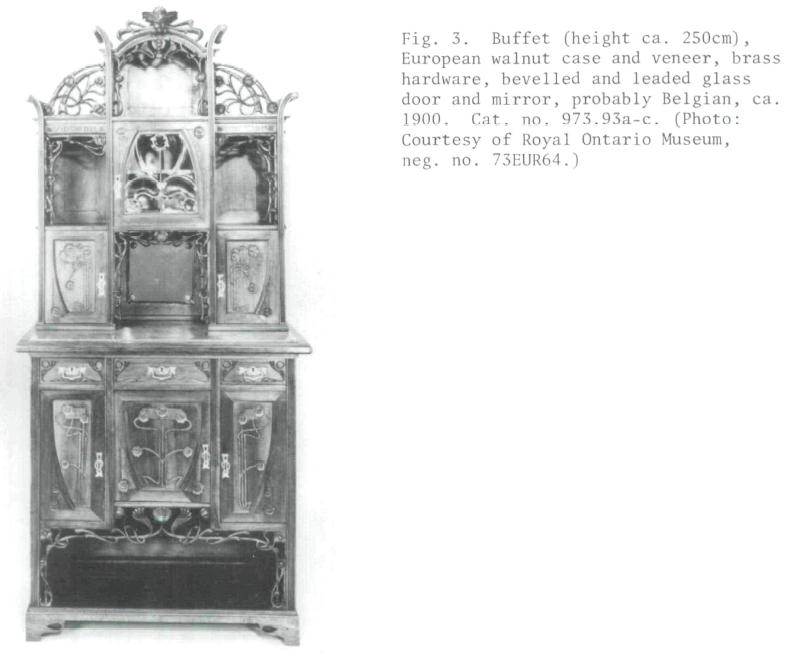 Display large image of Figure 3
Display large image of Figure 3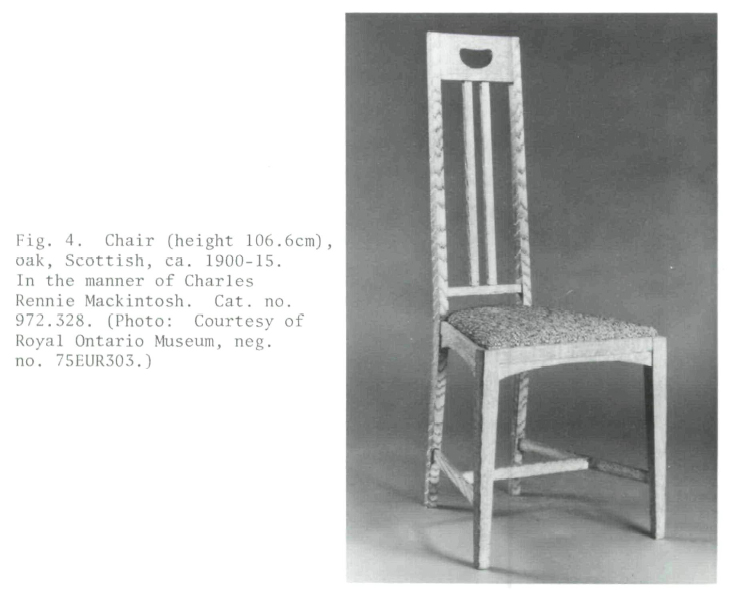 Display large image of Figure 4
Display large image of Figure 45 Most of the furniture came to the department as gifts. In many cases these were single pieces but extensive collections have also been donated or bequeathed. This includes the M. Langmuir Collection of Chests received in 1915, the collection of British furniture financed by the T. Eaton Company prior to 1930, and the fine British furniture donated by Josephine Eaton Burnside in 1941. Some of the showiest pieces, both British and Continental, came from Gerald Larkin and his sister Aileen. Prior to his death, W. Garfield Weston presented the department with an English panelled library, ca. 1750, and many fine pieces of furniture, mainly British.
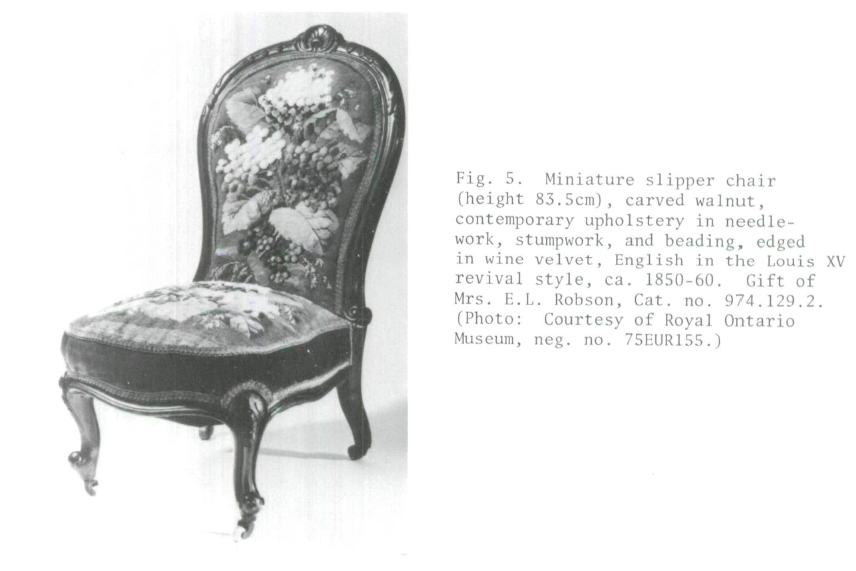 Display large image of Figure 5
Display large image of Figure 5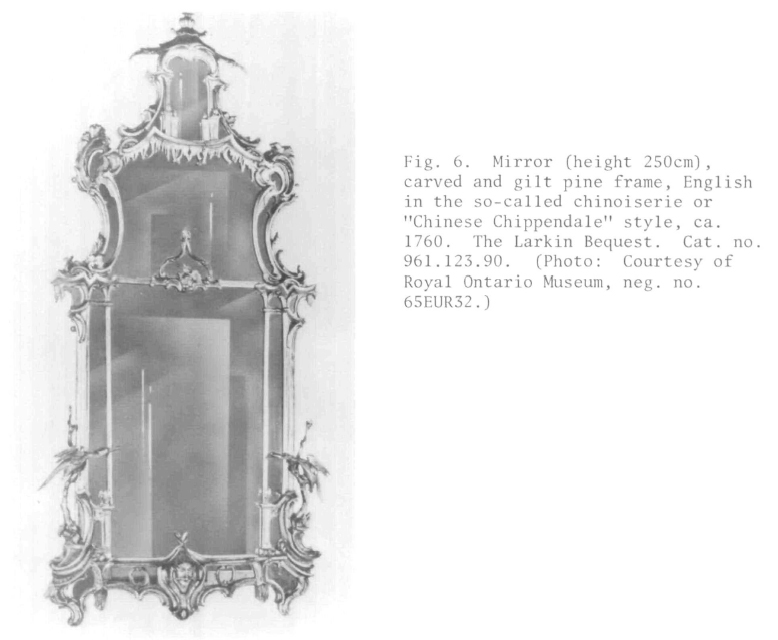 Display large image of Figure 6
Display large image of Figure 66 Before the complete closure of the European Galleries in the fall of 1979, the furniture was display in chronological sequence with the British and Continental material prior to 1900 in separate areas. Samples of woodwork and other decorative arts were part of the presentation and eleven period rooms, ca. 1600 to 1900, showed part of the furniture in reconstructed settings. The most successful rooms were a French Louis XV salon from a Paris town-house, a Queen Anne panelled room, and an English panelled room, ca. 1740, of finely carved and painted pine. Like most of the collections in the main building, the furniture is presently inaccessible and will likely remain that way until the new galleries are opened following renovations, March 1983 at the earliest. Due to the heavy teaching and research demands made on this collection, it is likely that the furniture will be exhibited in a manner similar to the previous arrangement. Gerard Brett, an earlier curator of the department and director of the Museum, published a handbook to the collection, English Furniture and its Setting from the Later Sixteenth to the Early Nineteenth Century (Toronto: Royal Ontario Museum/University of Toronto Press, 1965). This very readable small volume is unfortunately no longer in print. Admittedly more research and cataloguing could be done; nonetheless, this is the best researched and catalogued collection of its type in Canada. It is complimented by the holdings of the museum's library and the Fine Arts Section of the Metropolitan Toronto Public Library. Contact persons for the collection are:
Peter Kaellgren - Curatorial Fellow, British and twentieth-century furniture.
7 A survey of the furniture collections of the Royal Ontario Museum would be incomplete without mentioning the collection of Chinese furniture in the Far Eastern Department. Before renovations began in 1979 an entire gallery, including an area set up as a scholar's study, was devoted to this furniture. The Far Eastern Department also owns a few pieces of Japanese and Korean furniture. Several modern replicas of ancient Greek furniture are found in the Greek and Roman Department and an interest in Middle Eastern furniture is maintained in the West Asian Department.